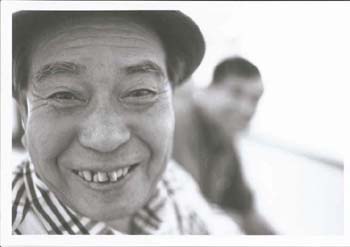Galleries to Catch Your Breath in
Back to Contents of Issue: December 2002
|
|
|
|
by Craig Mod |
|
 AMONG CAFES, DEPARTMENT stores and shoe shops of Ginza lie a few meditative spaces of photographic calm. Sponsored by the likes of Nikon, Canon, Contax, Leica and Fuji, the free galleries in Ginza are rotated weekly (usually on Wednesdays) and consistently feature high quality work. AMONG CAFES, DEPARTMENT stores and shoe shops of Ginza lie a few meditative spaces of photographic calm. Sponsored by the likes of Nikon, Canon, Contax, Leica and Fuji, the free galleries in Ginza are rotated weekly (usually on Wednesdays) and consistently feature high quality work. To give one an idea of how competitive some of the spaces are, Fuji Gallery 2 has a waiting list of over one year, and that's just for photographers who pass the screening panel. As you might expect, to even be considered requires that you've used Fuji film and chemicals throughout the entire development and printing processes. Similarly, to display in the Canon, Nikon or Leica galleries, you need to have used the respective manufacturer's bodies and lenses to shoot the photos you want to display. The end result is that galleries are always looking for the highest quality and most interesting photographs to display as a form of self-promotion. After all, that awe-inspiring, time-lapse, color-saturated Velvia shot made with a Contax N1 and a Zeis 35mm lens might be enough to push one of the camera aficionado oyaji, or old men, who frequent the Ginza galleries into buying another camera body or lens. And when I say oyaji, I'm not kidding. The one mainstay of these galleries, besides photographs, is an ever-present contingent of middle-aged Japanese men who love photography. Oddly enough, these lovers of captured light all seem to shop at the same stores. Apparently, to be a true oyaji photographer requires a floppy fisherman's hat, a photo vest (with pockets for film and such), some khakis, a light tan jacket and a killer smile. Of all the galleries, the two that are the most eclectic are Contax and Leica. When you step out of the elevator into the Contax gallery, you enter a small, dark space that smells like your grandmother's house (think mothballs). The walls, floor and ceiling are completely black. For the most part, the only lighting is on the photographs hanging on the walls. There is always a receptionist there to answer your questions concerning which equipment, film, filters and printing processes were used in the creation of the photography. Sometimes the photographer is there for you to barrage with questions. The photos in the Contax gallery are almost always printed very large and are usually color. While there is no theme that the gallery abides by, I have noticed a lot of nature photography. And the prints are beautiful. The colors are bright, and the shots are always done in interesting enough ways (through skewed angles, filters, et cetera) to somehow spice up those 20 giant shots of Mount Fuji. If Contax is grandma's house, Leica is your yuppie cousin's downtown loft. The room is extremely bright. The walls are white, the floors hardwood. There is a desk for a receptionist, but I have never seen one there. In the middle of the rectangular room is a cluster of benches, usually occupied by those aforementioned men in the floppy hats. On the walls are usually small black and white prints, often of people or weird objects. During the month of June, the gallery ran an entire show featuring works by German food photographer Oliver Brachat. Prints of spaghetti hanging off forks, a fish head in a cup, and cheesecake were suspended around the room. Brachat uses long lenses and short depths of field to bring a soft intimacy to the food -- a style for which he has become renowned. So considering all of the technology, business and neon that Tokyo is steeped in, it's nice to know there are places where you can take a moment, sit down and meditate on the subtle Zen quality of a picture of peas in oil -- and you can do it with a bunch of smiling middle-aged men. @ Craig Mod, a former J@pan Inc intern, is an avid photographer. His portfolio includes our September 2002 cover. |
|
Note: The function "email this page" is currently not supported for this page.





